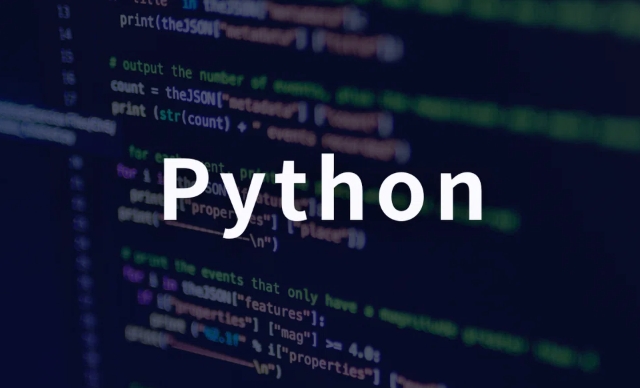python memory management example
Python's memory management is based on reference counting and garbage collection mechanisms. 1. The reference counting mechanism ensures that objects are released immediately when the number of references is 0. The return value of sys.getrefcount() is 1 more than the actual reference because it increases its reference itself; 2. Circular references cannot be cleaned through reference counting, and it depends on the generational recycling of the gc module. Calling gc.collect() can recycle unreachable objects; 3. In actual development, long-term holding of large object references should be avoided. We can use weakref weak references, timely place None to release memory, and use tracemalloc to monitor memory allocation; 4. Summary: Python combines reference counting and garbage collection to manage memory. Developers can improve program efficiency through reasonable use of tools and optimized reference management. Although memory management is automatic, it needs to pay attention to the risks of circular references and memory leakage.

Python's memory management is mostly automated for developers, but understanding its underlying mechanisms can help write more efficient code. Here is a concrete example to illustrate how Python memory management works, including reference counting, garbage collection, and object lifecycle.

1. Example of reference counting mechanism
Python uses reference counts to track the usage of objects. When an object's reference count becomes 0, it is immediately released.
import sys # Create a list object a = [1, 2, 3] print(sys.getrefcount(a)) # Output: 2 (a and getrefcount parameters references) b = a print(sys.getrefcount(a)) # Output: 3 c = a print(sys.getrefcount(a)) # Output: 4 # Delete the reference del b print(sys.getrefcount(a)) # Output: 3 del c print(sys.getrefcount(a)) # Output: 2 del a # At this time, the reference count is 0 and the object is released
⚠️ Note:
sys.getrefcount()itself adds a reference, so the result is always 1 more than the actual one.
2. Recycling References and Garbage Collection (GC)
Reference counting cannot handle circular references, so Python's garbage collector (gc module) is needed.
import gc
# Create a circular reference def create_cycle():
x = {}
y = {}
x['y'] = y
y['x'] = x
return x # Return the reference, but the internal loop reference z = create_cycle()
# z points to a circular reference structure del z # Delete external references, but x and y still refer to each other# Manually trigger garbage collection collected = gc.collect()
print(f"Retrieve {collected} objects") # Usually output 2 (two dictionaries) In this example, even if no variables refer to these two dictionaries after del z , they still cannot be released by reference counting because they refer to each other. Python's generational garbage collector detects and cleanses such unreachable objects.

3. Memory management tips (practical suggestions)
- Avoid unnecessary large object references : for example, when caching large amounts of data, consider using weak references (
weakref). - Dereference large objects in time : Set to
Noneafter processing big data to help quickly release memory. - Monitor memory usage : You can use the
tracemallocmodule to track memory allocation.
import tracemalloc
tracemalloc.start()
# simulate memory allocation data = [i for i in range(10000)]
current, peak = tracemalloc.get_traced_memory()
print(f"Current memory usage: {current / 1024:.1f} KB")
print(f"Peak Memory Usage: {peak / 1024:.1f} KB")
tracemalloc.stop()4. Summary of key points
- Python manages memory using the reference counting garbage collection mechanism.
- The object is released immediately when the reference count is 0.
- Recycling references require auxiliary cleaning of the GC module.
- Developers can optimize memory usage through tools such as
gcandtracemalloc.
Basically all this is not complicated but easy to ignore.
The above is the detailed content of python memory management example. For more information, please follow other related articles on the PHP Chinese website!

Hot AI Tools

Undress AI Tool
Undress images for free

Undresser.AI Undress
AI-powered app for creating realistic nude photos

AI Clothes Remover
Online AI tool for removing clothes from photos.

Clothoff.io
AI clothes remover

Video Face Swap
Swap faces in any video effortlessly with our completely free AI face swap tool!

Hot Article

Hot Tools

Notepad++7.3.1
Easy-to-use and free code editor

SublimeText3 Chinese version
Chinese version, very easy to use

Zend Studio 13.0.1
Powerful PHP integrated development environment

Dreamweaver CS6
Visual web development tools

SublimeText3 Mac version
God-level code editing software (SublimeText3)

Hot Topics
 Laravel lazy loading vs eager loading
Jul 28, 2025 am 04:23 AM
Laravel lazy loading vs eager loading
Jul 28, 2025 am 04:23 AM
Lazy loading only queries when accessing associations can easily lead to N 1 problems, which is suitable for scenarios where the associated data is not determined whether it is needed; 2. Emergency loading uses with() to load associated data in advance to avoid N 1 queries, which is suitable for batch processing scenarios; 3. Emergency loading should be used to optimize performance, and N 1 problems can be detected through tools such as LaravelDebugbar, and the $with attribute of the model is carefully used to avoid unnecessary performance overhead.
 Integrating PHP with Machine Learning Models
Jul 28, 2025 am 04:37 AM
Integrating PHP with Machine Learning Models
Jul 28, 2025 am 04:37 AM
UseaRESTAPItobridgePHPandMLmodelsbyrunningthemodelinPythonviaFlaskorFastAPIandcallingitfromPHPusingcURLorGuzzle.2.RunPythonscriptsdirectlyfromPHPusingexec()orshell_exec()forsimple,low-trafficusecases,thoughthisapproachhassecurityandperformancelimitat
 Laravel raw SQL query example
Jul 29, 2025 am 02:59 AM
Laravel raw SQL query example
Jul 29, 2025 am 02:59 AM
Laravel supports the use of native SQL queries, but parameter binding should be preferred to ensure safety; 1. Use DB::select() to execute SELECT queries with parameter binding to prevent SQL injection; 2. Use DB::update() to perform UPDATE operations and return the number of rows affected; 3. Use DB::insert() to insert data; 4. Use DB::delete() to delete data; 5. Use DB::statement() to execute SQL statements without result sets such as CREATE, ALTER, etc.; 6. It is recommended to use whereRaw, selectRaw and other methods in QueryBuilder to combine native expressions to improve security
 Reactive Programming in Java with Project Reactor and Spring WebFlux
Jul 29, 2025 am 12:04 AM
Reactive Programming in Java with Project Reactor and Spring WebFlux
Jul 29, 2025 am 12:04 AM
Responsive programming implements high concurrency, low latency non-blocking services in Java through ProjectReactor and SpringWebFlux. 1. ProjectReactor provides two core types: Mono and Flux, supports declarative processing of asynchronous data flows, and converts, filters and other operations through operator chains; 2. SpringWebFlux is built on Reactor, supports two programming models: annotation and functional. It runs on non-blocking servers such as Netty, and can efficiently handle a large number of concurrent connections; 3. Using WebFlux Reactor can improve the concurrency capability and resource utilization in I/O-intensive scenarios, and naturally supports SSE and WebSo.
 Using MapStruct for Painless Bean Mapping in Java
Jul 28, 2025 am 03:20 AM
Using MapStruct for Painless Bean Mapping in Java
Jul 28, 2025 am 03:20 AM
MapStruct is a compile-time code generator used to simplify mapping between JavaBeans. 1. It automatically generates implementation classes by defining interfaces to avoid manually writing lengthy set/get mapping code; 2. It has type-safe, no runtime overhead, supports automatic mapping of the same name fields, custom expressions, nested objects and collection mapping; 3. It can be integrated with Spring and uses @Mapper(componentModel="spring") to inject mapper into Springbean; 4. Simple configuration, just introduce mapstruct dependencies and annotationProcessorPaths inserts
 Optimizing Memory Usage in Java Applications
Jul 28, 2025 am 02:40 AM
Optimizing Memory Usage in Java Applications
Jul 28, 2025 am 02:40 AM
UseefficientdatastructureslikeArrayListoverLinkedListandprimitivecollectionstoreduceoverhead;2.Minimizeobjectcreationbyreusingobjects,usingStringBuilderforconcatenation,andcachingexpensiveobjects;3.Preventmemoryleaksbynullifyingreferences,usingstatic
 Notepad find and replace with regex capture groups
Jul 28, 2025 am 02:17 AM
Notepad find and replace with regex capture groups
Jul 28, 2025 am 02:17 AM
Use regular expression capture group in Notepad to effectively reorganize text. First, you need to open the replacement dialog box (Ctrl H), select "Search Mode" as "regular expression", 1. Use () to define the capture group, such as (\w ) to capture words; 2. Use \1 and \2 to reference the corresponding group in the replacement box; 3. Example: Exchange the name "JohnDoe" as "Doe, John", find (\w )\s (\w ), replace it with \2,\1; 4. Date format conversion 2023-12-25 to 25/12/2023, find (\d{4})-(\d{2})-(\d{2}), replace it with \3/\2/\1; 5. Log reordering can extract time, level, ID and other information
 python ternary operator example
Jul 28, 2025 am 02:57 AM
python ternary operator example
Jul 28, 2025 am 02:57 AM
Python's ternary operator is used to concisely implement if-else judgment, and its syntax is "value_if_trueif conditionelsevalue_if_false"; 1. It can be used for simple assignment, such as returning the corresponding string based on positive and negative values; 2. It can avoid division errors, such as determining that the denominator is non-zero and then division; 3. It can select content according to conditions in string format; 4. It can assign labels to different elements in list derivation formula; it should be noted that this operator is only suitable for binary branches and should not be nested multiple layers. Complex logic should use the traditional if-elif-else structure to ensure readability.








